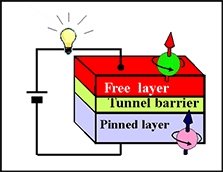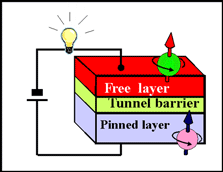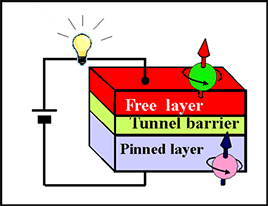Tunnel Magnetic Resistance (TMR)
Magnetic Tunnel Junction (MTJ)
Spin and Charge Transport
Abstract:
The Magnetic Tunnel Junction (MTJ) consists of two ferromagnetic metals, which are are separated by an ultra thin dielectric layer. The dielectric layer is sufficiently thin so there is an electron tunneling between the ferromagnetic layers. Still, the dielectric layer is sufficiently thick to prevent any exchange interaction between the ferromagnetic layers and therefore the magnetization of layers can be changed independently.
The resistance of MTJ substantially depends on mutual magnetization directions of the ferromagnetic layers. It is smallest when magnetization directions are parallel and is largest when magnetizations are opposite.
Magneto-transport though a MTJ is unique and is determined by magnetic and tunneling properties of interfacial states at both side of the MTJ
Content
1.
magnetic tunnel junction (MTJ) |
Reading |
Writing |
 |
 |
| The conductivity of MTJ depends on mutual directions of magnetizations (spins) of the ferromagnetic metals. The conductivity of MTJ is smallest, when magnetizations (spins) are parallel in both metals. The conductivity of MTJ is largest, when magnetizations (spins) are opposite each other. |
A sufficiently- large electrical current reverses the magnetization of a thin "free" layer. The direction, into which the magnetization is reversed, depends on the polarity of the electrical current. Therefore, a electrical pulse can record or reset a data bit into the memory cell. |
|
| MTJ consists of two ferromagnetic metals separated by a thin isolator. The ferromagnetic metals are not exchange- coupled, therefore their magnetization can be changed independently. The isolator is very thin (~1 nm), therefore a tunneling current can flow between metals |
| MTJ is used as a memory cell in Magnetic Random Access Memory |
| click on image to enlarge it |
("free" and "pin" layers)  Usually one layer of a MTJ is made a magnetically harder and thicker. It is called the "pin" layer and it is harder to its magnetization by a current and it requires a larger magnetic field for its magnetization reversal. The second layer of a MTJ is made a magnetically softer and thinner. Its magnetization can be reversed by an electrical current.
Usually one layer of a MTJ is made a magnetically harder and thicker. It is called the "pin" layer and it is harder to its magnetization by a current and it requires a larger magnetic field for its magnetization reversal. The second layer of a MTJ is made a magnetically softer and thinner. Its magnetization can be reversed by an electrical current.
(data storage)  A bit of data is stored in the MTJ by means of two stable magnetization directions of the "free" layer.
A bit of data is stored in the MTJ by means of two stable magnetization directions of the "free" layer.
(reading)  The data reading is done be measuring resistivity (a measurement a small current) of MTJ. The resistivity is smaller when the magnetization of "free" layer is parallel to the magnetization of the "pin" layer. The resistance is larger, when the magnetization direction are opposite.
The data reading is done be measuring resistivity (a measurement a small current) of MTJ. The resistivity is smaller when the magnetization of "free" layer is parallel to the magnetization of the "pin" layer. The resistance is larger, when the magnetization direction are opposite.
(writing)
Puzzle of a magnetic tunnel junction
Puzzle of magnetic tunnel junction |
 |
| |
| |
| click on image to enlarge it |
 The spin conservation law is a very strict law (nearly the same as the energy conservation law). However, a sufficient electrical current flowing in a MTJ, in which the magnetization of both "pin" and "free" layers e.g. in the up direction, switches the magnetization of the "free" layer into the down direction. It means that a magnetic system, which all region spin- polarized in spin-up direction and there is no region of spin-down direction, the electrical current creates a region ( the "free" layer) of spin-down direction. The spin- down direction is created from nowhere. This behavior cannot be explained by the spin injection between layers and the spin conservation law seems to be broken.
The spin conservation law is a very strict law (nearly the same as the energy conservation law). However, a sufficient electrical current flowing in a MTJ, in which the magnetization of both "pin" and "free" layers e.g. in the up direction, switches the magnetization of the "free" layer into the down direction. It means that a magnetic system, which all region spin- polarized in spin-up direction and there is no region of spin-down direction, the electrical current creates a region ( the "free" layer) of spin-down direction. The spin- down direction is created from nowhere. This behavior cannot be explained by the spin injection between layers and the spin conservation law seems to be broken.
(explanation of the effect)  The origin of this effect is the unique features of the interfacial states of the MTJ
The origin of this effect is the unique features of the interfacial states of the MTJ
The magneto-transport through the is complex interactions between spins of spin- polarized conduction electrons, spins of localized d- electrons and the spins of interfacial states at each sides of the MTJ.
Interface states of MTJ
(fact)  The interfacial states mostly determines the magneto- transport and tunneling properties of the MTJ.
The interfacial states mostly determines the magneto- transport and tunneling properties of the MTJ.
 Why the interfacial states are so special?
Why the interfacial states are so special?
(reason 1) The spin properties of the interfacial states are between spin properties of the localized d- electrons and conduction electrons. Therefore, their spin features are unique and different from both the conduction and localized electrons.
(reason 2) The interfacial couples conduction and localized d- electrons. As a result, the interaction between them substantially increases due to the interfacial states.
Even though in the ferromagnetic metal the conduction and localized d- electrons interacts with each other due to the sp-d exchange interaction and mutual scatterings, in the bulk of metal such interaction is weak. There are two reasons why it is weak. (reason 1: size difference ): The size of localized d- electrons is very small (about diameter of atomic orbital. In contrast, the length of conduction electrons is longer (~ 1nm and longer) (see here). An interaction between two electrons is proportional to their overlap. (reason 2: running vs. steady ): The localized d- electrons do not move along lattice. In contrast, the contrast the conduction electrons moves along the lattice at substantial speed.

 I am strongly against a fake and "highlight" research
I am strongly against a fake and "highlight" research 






